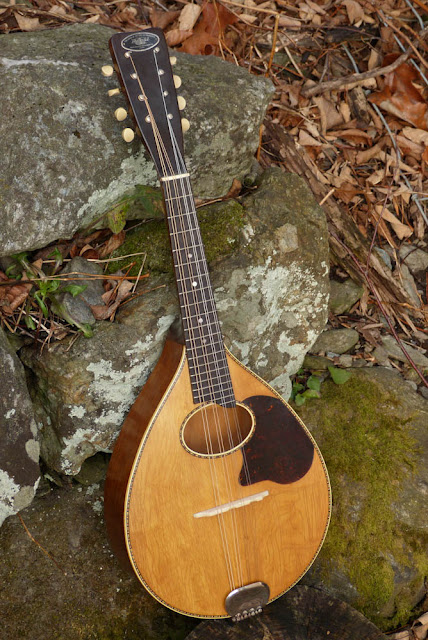1930s Regal Flatback Mandolin
Regal had been making this basic mandolin style since the early 20s, but this particular one definitely dates to the early-mid 30s. It has a few changes compared to earlier ones including a slightly wider nut, simplified satin finish, a smaller inlaid pickguard, and a longer scale. By the late 30s Regal was often using a straight 14" scale but this one has the "Gibson standard" 13 7/8" length. Because of the light construction, however, I still tend to favor period-appropriate 32w-9 gauged strings (GHS A240 set) -- and as you can hear in the soundclip, they still put out tons of tone.
Like most of these Regals, this one needed a neck reset (the idiotic dowel joint always peels away from the body), fret level/dress, new bridge, light cleaning, and a good setup. It was otherwise really clean and has no cracks and very little wear and tear. This is a customer's instrument (he's a fiddler) and I'm hoping this gets his mandolin juices flowing. These old Regals always sound about 300% better than they should and, once work is done, play that way, too.
This mando is solid spruce (canted-top) over solid birch. The neck is probably poplar and the board is stained maple. The original bridge was maple, too, but it was damaged and honestly didn't sound that great even after I fixed it up.
There's that standard Regal headstock shape. Original bone nut, too...
My new compensated bone bridge borrows the original bridge's shape to a T.
Don't you love the multicolored purfling and the crackling to the finish?
I also really like these "Bell Brand" tailpieces as they're super-easy to string.
These tiny-post tuners seem to have been used by Regal from the late 20s only into the early 30s.
Do you see it? Check the bottom of the heel. Yep. Countersunk screw in there!
The doweled joints on these Regals are designed to fail and either an additional screw or bolted-joint setup are the only ways I've found to cure the bad joint of its design failure. I don't just slap the screw in there, however... I also give the joint its proper back-angle and reglue the dowel before I'm done with it and cap it all off.
The reason the joint fails is that the bottom half of the heel is simply "flat" to the neckblock and there's a dowel reinforcing it only in the top half of the heel. This is also the reason why I tend to not do an invisible bolted conversion -- I don't like the idea of removing so much support wood for the screw/bolt mod.

















Comments